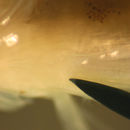en
names in breadcrumbs


Analogues: The 10/10 sand goby clade share fin-ray counts, morphology, and most markings as larvae and new recruits. C. dicrus and the other head-striped sand gobies develop short stripes on top of the head very early in transition, separating them from the spotted-head gobies (i.e. C. eidolon, C. thrix, C. alloides, C. kuna, and the non-sand Coryphopterus species). Transitional C. dicrus diverge
Diagnosis: Modal fin-ray counts of D-VI,10 A-10 and Pect-18-20 with fused pelvic fins indicate the 10/10 Coryphopterus sand gobies, i.e. Coryphopterus dicrus, C. glaucofraenum, C. tortugae, C. bol, C. eidolon, and C. thrix. The distinguishing features of adult C. dicrus are mostly not present on recruits and small juveniles.
Coryphopterus dicrus, the Colon goby, is a species of goby found in the Western Atlantic Ocean from southern Florida and the Bahamas all the way to Brazil.[1]
This species reaches a length of 5.0 cm (2.0 in).[2]
Coryphopterus dicrus, the Colon goby, is a species of goby found in the Western Atlantic Ocean from southern Florida and the Bahamas all the way to Brazil.
This species reaches a length of 5.0 cm (2.0 in).